What is cheaper and better - a gas tank or main gas? Comparative review
Using gas in private households allows you to significantly save on heating, hot water and cooking.Despite all the economic crises, blue fuel remains the cheapest energy source.
But what is better - a gas tank or main gas - to choose for your home? Each of these gas supply methods has its own advantages and price. To make the right choice, you need to take into account all the nuances of both cottage gasification schemes.
The content of the article:
What is main (natural) gas?
For ordinary people who are far from oil and gas production, analyzing all the nuances of the “gas” issue in detail often causes a headache. There is natural, liquefied, bottled, compressed, main gas, etc. Plus there are a bunch of abbreviations (CNG, LNG, LPG, GMT, APG). And all this is about the fuel that we use in everyday life to heat water (coolant) and cook.
It is quite difficult to understand all types of this fuel, so familiar to many Russians, from scratch.
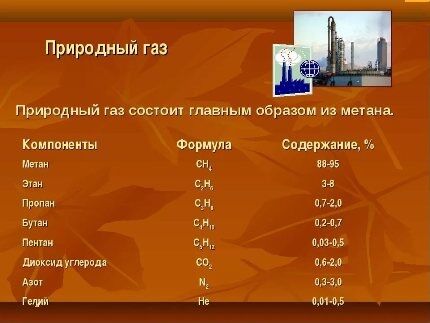
As such, natural gas, extracted from the depths of the earth, is a mixture of:
- methane;
- heavy hydrocarbons (ethane, propane, butane, etc.);
- hydrogen and hydrogen sulfide;
- water vapor;
- nitrogen;
- helium and other inert gases.
Depending on the deposit, the share of the first component in this mixture reaches 70–98%.
However, the “natural gas” that enters apartments and houses through pipes is methane that has already been purified from impurities with a tiny amount of odorant (a substance with a strong unpleasant odor that makes leak detection easier).
It is unsafe to supply the entire mixture extracted from the ground through gas pipelines for domestic needs without treatment. It contains many explosive and harmful components. It’s easier and safer to purify methane from everything else.
After purification at the field, this purely methane gas enters the gas transportation system (GTS). And from it, through gas distribution and compressor stations, it is supplied through gas pipelines, first to populated areas, and then to consumers.
This is how natural gas enters private homes and city apartments to be burned in gas stoves, boilers and boilers.
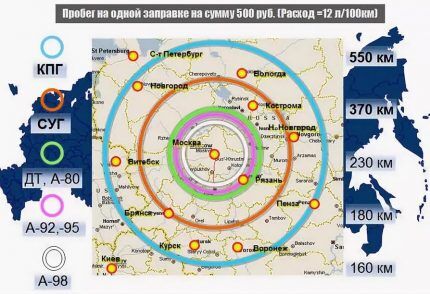
The gas in the apartment and the gas fuel based on methane are identical in composition. However, the first “flows” through the pipes in a gaseous state. But the second one is pumped into car cylinders in a form compressed to a pressure of 200–220 bar. This type of gas motor fuel is called compressed fuel (CNG). This is what is sold at Gazprom gas stations.
At the same time, there is also LPG (liquefied petroleum gas), which is also often used for filling into cars. But it no longer consists of methane, but of a mixture of propane and butane. More on that later - this is exactly what is pumped into the gas tanks.
The methane class also includes natural gases:
- LNG (liquefied).
- APG (adsorbed).
The first, to simplify transportation and storage, is liquefied by cooling at minus 1600WITH.It is he who is transported in huge tankers across the oceans.
The second option is methane, which is adsorbed on a solid porous sorbent. Unlike LNG, its storage does not require equipment to maintain ultra-low temperatures.
At the same time, the pressure in the container does not rise above 30–50 bar, so storing and transporting it is much easier and safer. However, this technology has not yet become widespread in Russia and the world, due to the high cost of producing the adsorbent.
Features of gas holder (liquefied) fuel
A gas holder (GasHolder) is a banal tank for storing gas (propane + butane). It is pumped there in liquefied form. Then gradually this “liquid” turns into a gaseous state, increasing the pressure in the container. And due to the high pressure, the gas is squeezed out of the tank into the pipes for supply to the house.
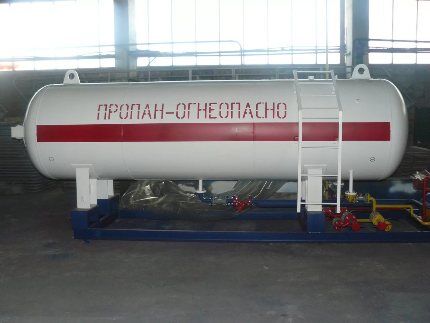
In fact, butane and propane are by-products remaining after the separation of methane from “natural gas” raised from the depths. Their share in the mixture pumped out of the ground often reaches 30%.
Plus, they are formed during the processing of associated gas, which comes out of wells along with oil. They have to either be burned in flares at the field, or find ways to use them in the energy sector.
Gas tanks can be used to store various gases. But for autonomous gas supply to private homes, it is customary to use equipment designed for a propane-butane mixture. It is also called liquefied petroleum gas (LPG). Liquefying methane for injection into such household containers is too expensive and unprofitable.
A mixture of liquefied propane and butane (LPG) differs in:
- winter;
- summer
Butane is cheaper than propane. But it freezes faster at negative atmospheric temperatures, so it is added to the winter mixture in smaller proportions. In winter, LPG is more expensive not because of the desire of power engineers to earn more, but because of the technological need to increase the percentage of expensive propane in it.
However, it is not worth purchasing liquefied gas for future use in the summer. In winter, with severe frosts, the summer composition may “freeze”. It will not turn into ice, but it will change from a liquid to a gaseous state in smaller volumes.
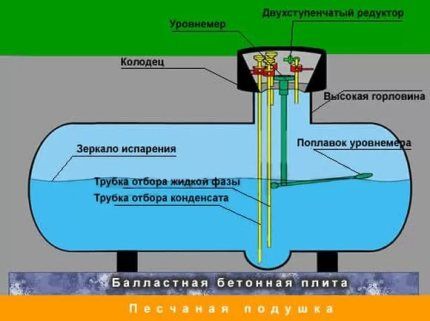
Gas holders are vertical and horizontal, and are also divided into:
- underground;
- aboveground.
In Russian climatic conditions, it is recommended to install only the underground version. At low outside temperatures, liquefied propane-butane begins to evaporate less efficiently.
It is easier to dig a deep pit so that the bottom of the gas tank is below the freezing level of the soil in the area. It is more expensive to insulate and artificially maintain the temperature parameters required for evaporation in the container by installing special evaporators.
Some “experts” claim that vertical gas holders have lower thermal efficiency compared to their horizontal counterparts. The evaporation mirror inside them is much smaller. And indeed it is. The smaller the area of liquid on top means less of it evaporates.
However, in vertical LPG tanks the evaporation process occurs at a slightly higher rate, which fully compensates for the smaller size of the “mirror”. The end result is almost the same. It is not for nothing that in Scandinavia, where the climate is in many ways similar to Russia, they prefer to install gas tanks in a vertical design.
Comparison of gas from the main and gas tank
Comparing both options gas supply to a private house, it is necessary to look both at the cost of purchasing a cubic meter of gas, and at the estimate for installing equipment and the price of its subsequent operation.
All parameters of both systems should be taken into account. At the same time, when choosing which is initially cheaper - a gas tank and main gas, it is necessary to analyze what is easier to repair and maintain.
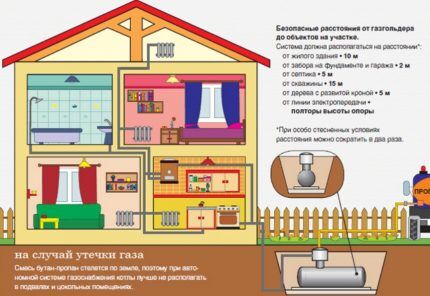
A gas holder is, first of all, complete autonomy in the energy supply of a private home. The main gas can be turned off at any time. It is impossible to completely insure against accidents on gas pipelines.
In this respect, piped blue fuel is similar to electricity. The general network collapsed, and the cottage found itself without electricity and gas supplies. And gas holder fuel is always available. You just need to make sure the tank is full.
Factor #1: Connection cost
If you look at the average prices for connecting main gas and gas tank installation, then the first option wins greatly. You can now connect a cottage to the gas main for 50-100 thousand rubles.
If you choose the second method, you will have to spend about 200 thousand rubles on gas tank equipment alone. The larger it is, the more expensive it is. Plus installation and excavation work. But there are a number of nuances here.
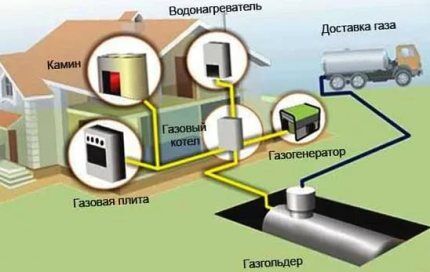
The main problem with connecting main gas is the timing of all necessary work and approvals. If the village already has a pipe, then everything will happen relatively quickly and quite inexpensively. But if there are more than two hundred meters from the house to the highway, then there will be a lot of hassle with connecting.
To connect the cottage to the gas pipe, necessary:
- Prepare gas consumption calculations.
- Apply for technical conditions.
- Get these specifications (takes up to a month).
- Prepare a project for the gas network in the house and from it to the main line (a couple more weeks).
- Conclude a connection agreement with gas workers by providing them with project documentation.
- Complete the installation of gas equipment (several days, provided that free installers are quickly found).
- A representative of the main methane supplier checks the functionality of the equipment and wiring both inside and outside the house, followed by the conclusion of a service agreement (you can wait another month for this person’s arrival).
As a result, the minimum is 3-4 months. And this is if no problems arise during the approvals and installation process. Usually everything drags on for six months, price of connection to centralized gas supply also makes you think about its necessity.
If the village is not included in the regional gasification program, thanks to which many connection issues have already been resolved, then there is no point in dealing with this topic yourself. There will be a lot of headaches and going through the authorities.
But the process of gasifying a private house using a gas holder occurs in just 1–3 days. Private owners do not need to obtain approval from supervisory authorities for the installation of such an installation on their land. Decide on the cost gas holder installations Our recommended article will help.
You just need to dig a pit for the LPG tank, install it there and connect the pipes to it. All the necessary sensors, automatic control systems and valves are already included in the gas tank kit.
And one more nuance. The connection from the highway to the house can be done on almost any site. With a gas holder the situation is radically different. It must be removed at a certain distance from buildings, wells and roads. Not every estate is suitable for placing gas tank equipment; a suitable place for the tank may not be found.
Factor #2: Energy Efficiency and Cost of Maintenance
At analysis of gas fuel costs it is necessary to separate the cubic capacity (displacement) of methane in the pipe and propane-butane LPG in the vehicle delivering liquefied fuel to the customer. If you look at the price tag in rubles/m3, it turns out that main gas costs three to four times less than propane-butane.
However, in the first case, fuel is supplied in a gaseous state, and in the second, in a liquid state. As a result of evaporation, a liter of this “liquid” turns into 200–250 liters of gas. Moreover, here it is also necessary to take into account the ratio of propane and butane in the gas holder LPG. They have different densities.

If we compare the calorie content of two types of gas fuel, then propane-butane will be ready to give a head start to methane. When burning one cube of a propane-butane mixture in a gaseous state, about 28 kW is released, while methane can produce only about 9 kW.
With an average calculation, a cottage of 100 square meters requires about 3000–3100 m2 per year for heating3 methane or about 1000 m3 LPG. At the same time, you will have to pay three to four times less for the first gas. As a result, it turns out that fuel costs for the year as a whole end up being approximately equal.
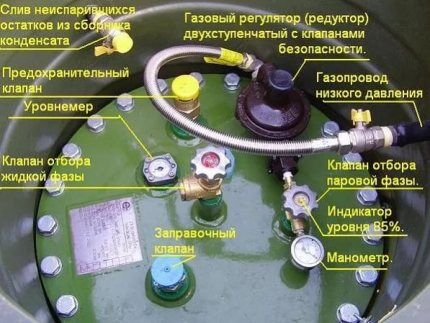
According to the standards of the Ministry of Emergency Situations, main natural gas belongs to the 4th, safest category of explosive gas substances. But propane-butane is included in the more dangerous 2nd group. Even with small concentrations of LPG in a room, it can explode from the slightest spark.
Moreover, methane itself is light; during leaks, it rises under the flow and dissipates or goes into ventilation. But the propane-butane mixture is heavy and sinks to the floor or ground, gradually accumulating there to critical levels.
From a safety point of view, main gas greatly outperforms tank gas. It is not for nothing that gas tanks are strictly prohibited from being installed next to wells and basements, where gas can leak due to leaks from the tank.
Standard distances for the location of a gas tank on a site are given here. The article we recommend describes in detail the rules for choosing a location for installing equipment of this type.
To avoid problems with LPG, tanks for it and rooms with boilers are often equipped with special gas sensors. They instantly react to an increase in gas concentration, warning the home owner about potential problems. You shouldn't skimp on them.
Conclusions and useful video on the topic
The following selection of videos will help you understand all the nuances of choosing equipment for gasification of a cottage.
Video #1. Connecting main gas step by step:
Video #2. Advantages of autonomous gasification:
Video #3. All the nuances of installing a gas tank:
In all respects, main gas for connection and consumption will cost less than LPG from a gas tank. This is especially true for the issue of initial expenses. But if there is no gas main near the house, then installing a pipe can also cost a pretty penny.
Here it is better to prefer the option with a gas tank: it is expensive, but it is completely autonomous and with it you will not need to worry about accidents on the gas pipeline.
What do you think is better: installing a gas tank or connecting to a centralized gas supply? Please write comments in the block below. Ask questions, post photos related to the topic of the article, share useful technical nuances known only to you.




After the construction of the country house, the question arose about connecting the gas system. Initially, I planned to connect the main gas: it is much cheaper and easier. But then, after analyzing all the pros and cons, I settled on installing a gas tank.There may be failures in the supply of the main supply, but with a gas tank you control the process yourself. A gas tank is expensive both to maintain and to install, but it outperforms the main line.
Over the 15 years of operation of the main gas pipeline, the gas was turned off once for 3 days.
I think this is not critical...
Even during long power outages, there was always one.
If the gas is normal, it will not freeze.
At home we heat 130 m2 using a 1450 liter gas holder. The gas lasted for less than 2.5 months, starting in October, when there was no frost at all. Maybe the service company was deceived or the workers were incompetent during installation? But the price for a month of heating was approximately 15,000 rubles.
I agree with Igor. Gas from a gas tank is very expensive. House 260m2 3000 liters was enough for 2 months. 2000 l at 1.5.
Those. in fact it turns out approx. 26,000 thousand. I don’t know what it is, the company’s deception or the incompetence of the workers during installation. I consider a gas tank as an intermediate option. Despite the high cost of connecting main gas, this is exactly what I am doing at the moment.
I'm wondering if it would be much more expensive to heat with electricity? Because the costs are just terrible.
A house of 200 m2 is connected to main gas, used for heating, water heating and a stove in the kitchen. For the year 24,000 rubles + maintenance 4,500 rubles/year and that’s it.
100 tr is a joke?! It costs us 700-1000tr to connect the main gas, new Moscow
There is a gross error in the article. The cost of heating with liquid gas from a gas holder, taking into account the different calorific values, is five times more expensive than with main gas.
Hello.We'll check and fix it, thank you.
Over almost 30 years of operation, main gas was turned off once for 1.5 days (they cited emergency damage to the pipeline), and electricity was turned off constantly and regularly for periods ranging from several hours to a couple of days (20 days a year). There was no question about gas supply, gas was on site, just design + installation.
The error is not 5 times. Having accepted, with a certain approximation, that from 4 liters of liquefied gas we get one cubic meter of gas fraction, and the heating consumption is 150 sq.m. - 300 cu.m. natural gas, heating the same area will require 100 cubic meters of LPG, or 400 liters, provided that the calorific value of LPG is 3 times higher (and this is nonsense). With the cost in the Republic of Belarus during the heating period of 1 cubic meter of natural gas being around 14 kopecks and the cost of a liter of LPG being 1.2 rubles, heating LPG will cost 1.2×4=4.8÷0.14=34 times.
Question about electric heating.
With the same tariffs for natural gas and a preferential tariff for electricity of 4 kopecks per kWh, heating with electricity is 3.5 - 4 times more expensive.
Today, natural gas is unrivaled by a wide margin in terms of efficiency, convenience and other indicators. And don’t believe any “SPECIALISTS” who want to convince you.
I live in a region where there is no gas supply. I heat my house with wood or coal. Electricity is rare because it is expensive. With a properly selected boiler and the entire heating system as a whole, heating with wood becomes inexpensive. Opponent of any gas, because There is no desire to live on a powder keg. Sensors or your own sense of smell, but this is not life when you are constantly on Fox. You are at work and your child has come home from school.There is no work if you are constantly wondering if there was some kind of leak and the child turned on the light in the toilet. In our troubled times, there are already enough reasons to worry about the family.